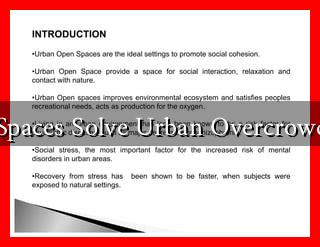-
Table of Contents
- Can Open Spaces Solve Urban Overcrowding Issues?
- The Importance of Open Spaces in Urban Environments
- Case Studies: Successful Implementation of Open Spaces
- 1. New York City’s High Line
- 2. Singapore’s Park Connector Network
- Statistics Supporting Open Space Development
- Challenges and Considerations
- Conclusion
Can Open Spaces Solve Urban Overcrowding Issues?
Urban overcrowding is a pressing issue faced by cities worldwide, leading to a myriad of challenges including traffic congestion, pollution, and a decline in the quality of life. As cities continue to grow, the need for innovative solutions becomes increasingly urgent. One potential remedy that has gained traction in recent years is the development of open spaces. This article explores how open spaces can alleviate urban overcrowding, supported by case studies, statistics, and expert opinions.
The Importance of Open Spaces in Urban Environments
Open spaces, which include parks, gardens, and recreational areas, play a crucial role in urban planning. They provide not only aesthetic value but also essential benefits that can help mitigate the effects of overcrowding. Here are some key reasons why open spaces are vital:
- Improved Mental Health: Access to green spaces has been linked to reduced stress and anxiety levels. Studies show that spending time in nature can enhance mood and overall well-being.
- Community Engagement: Open spaces serve as communal hubs where residents can gather, fostering social interactions and community cohesion.
- Environmental Benefits: Green spaces help improve air quality, reduce urban heat, and support biodiversity, contributing to a healthier urban ecosystem.
Case Studies: Successful Implementation of Open Spaces
Several cities around the world have successfully integrated open spaces into their urban landscapes, demonstrating their potential to alleviate overcrowding issues.
1. New York City’s High Line
The High Line, a linear park built on a former elevated railway, is a prime example of how repurposing urban space can create a vibrant public area. Since its opening in 2009, the High Line has:
- Attracted millions of visitors annually, boosting local businesses.
- Provided a green corridor that enhances biodiversity in an urban setting.
- Encouraged community events and activities, fostering social connections.
As a result, the High Line has not only improved the quality of life for residents but has also contributed to the economic revitalization of the surrounding neighborhoods.
2. Singapore’s Park Connector Network
Singapore has taken a proactive approach to urban planning by developing a comprehensive Park Connector Network (PCN). This initiative connects parks and green spaces across the city, promoting walking and cycling. Key outcomes include:
- Reduction in traffic congestion as more residents opt for walking or cycling.
- Enhanced accessibility to green spaces, encouraging outdoor activities.
- Improved air quality and urban biodiversity through increased greenery.
The PCN exemplifies how strategic planning can integrate open spaces into urban environments, addressing overcrowding while promoting a healthier lifestyle.
Statistics Supporting Open Space Development
Research supports the notion that open spaces can significantly impact urban living conditions. According to a study by the National Recreation and Park Association (NRPA):
- Communities with access to parks and recreational facilities report higher levels of physical activity.
- Urban areas with more green space experience lower temperatures, reducing the urban heat island effect.
- Access to parks is associated with lower rates of obesity and chronic diseases.
These statistics highlight the multifaceted benefits of open spaces, reinforcing their role in combating urban overcrowding.
Challenges and Considerations
While the benefits of open spaces are clear, several challenges must be addressed to maximize their effectiveness:
- Land Use Conflicts: In densely populated cities, finding available land for new parks can be difficult.
- Maintenance Costs: Open spaces require ongoing maintenance and funding, which can strain municipal budgets.
- Equitable Access: Ensuring that all communities have access to quality open spaces is essential for maximizing their benefits.
Conclusion
Open spaces present a viable solution to the challenges posed by urban overcrowding. By improving mental health, fostering community engagement, and providing environmental benefits, they can significantly enhance the quality of life in urban areas. Successful case studies from cities like New York and Singapore illustrate the potential of open spaces to transform urban landscapes. However, addressing challenges such as land use conflicts and maintenance costs is crucial for realizing their full potential. As cities continue to grow, prioritizing open spaces will be essential in creating sustainable and livable urban environments.
For more information on urban planning and the benefits of green spaces, visit the National Recreation and Park Association.

